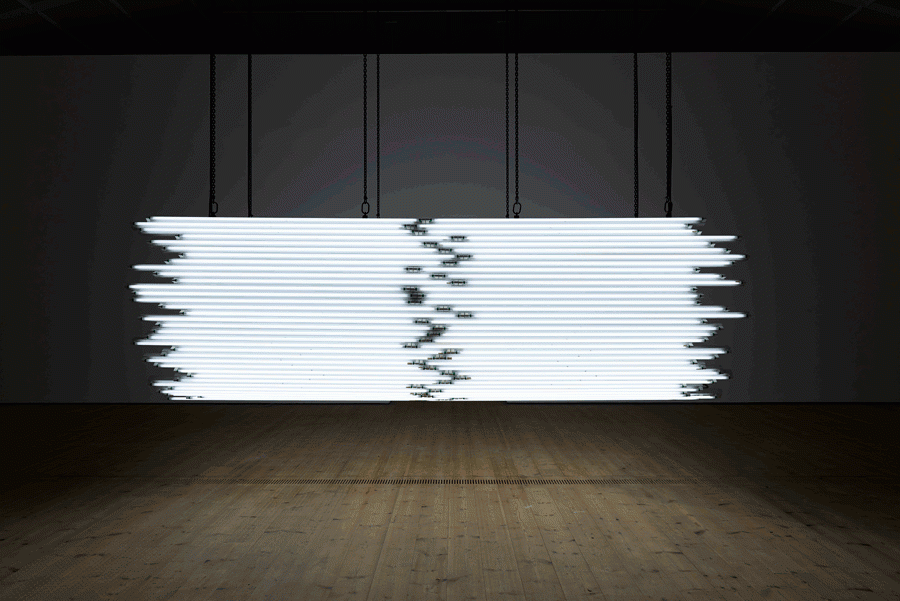Baltic Centre for Contemporary Art, Gateshead, 18 November – 26 February 2017
The first obstacle you encounter when visiting Monica Bonvicini’s exhibition is a huge halfpipe of fluorescent light tubes hanging from chains across the entrance to the gallery like the hull of an incandescent boat. Blinding, this mass of light – Light Me Black (2009) – is at once seductive and physically overwhelming, and draws you, bedazzled, into the artist’s first major survey exhibition at a British institution.
Bonvicini’s sculptures and installations aim to provoke an awareness of the architecture that surrounds them – be that public, private, institutional, urban or domestic – and the physical and psychological roles that that architecture plays in shaping a viewer’s identity – in terms of class, gender, sexuality and power. Making use of industrial building materials such as bricks, scaffolding, steel chains and sheet glass, Bonvicini’s work is neither polite nor apologetic. It is confrontational, derisive and antagonistic, as well as, at times, humorous.
Often recalling the modernist canon, several of the works that Bonvicini has placed in the fourth-floor gallery (where the exhibition begins) seem to embody a tongue-in-cheek play on the uber-masculinity and dogmatism of minimalist sculpture – Dan Flavin’s fluorescent tubes, for example, or Carl Andre’s Equivalent VIII (1966), which is called to mind by Bonvicini’s 7:30 hrs (1999–), a series in which she asks local bricklaying students (this time from Newcastle College) to build fragments from plans for their final exams. The result is a collection of awkward brickwork shafts incorporating dead ends, precarious mantels and bottomless holes, teasing Minimalism’s earnest seriousness.
Further obstructions fill this first space. A huge freestanding wall the height of the room splits the space. One side is covered with tiny collaged magazine images of limbs, a kaleidoscope of legs and arms opening and closing, while on the other side a series of eight peepholes at waist height ask the viewer to bend over to look through them, revealing images of exhibitions under construction elsewhere, and making us all expectant voyeurs. In this same gallery, an extravagant rococo-style silver staircase leading nowhere: Scale of Things (To Come) (2010) reveals itself, upon closer inspection, to be made entirely out of scaffolding and chains, while five of Bonvicini’s black-and-white tempera paintings depict the damage wreaked on domestic architecture by environmental disasters such as forest fires, hurricanes and tornadoes.
Downstairs in gallery three, one of Bonvicini’s largest projects to date extends her probe into stereotypical power-plays in architecture and construction. A vast grid of framed A4 sheets, What does your wife/girlfriend think of your rough and dry hands? (1999–), consists of a series of questionnaires delivered to builders internationally, asking a selection of questions, some straightforward, others belligerent or penetrating: ‘Is your trade creative? Have you ever designed your own building? Is your work erotic? Do you get on with your gay colleagues? What does your wife/girlfriend think of your rough and dry hands?’ The handwritten answers vary between outrage, amusement, honesty and deflection: a candid introduction to the second section of the show. In a sprawling installation of passageways, dark corners and dead ends, whose own plasterboard construction is left bare to see, Bonvicini has installed an assortment of works spanning her career that play on the idea of the artwork as fetish. Hammers, saws and pickaxes neatly laced, corsetlike, in black leather wait in low-lit display cabinets; a builder’s harness smothered in black polyurethane dangles from the ceiling (Harness, 2006); and a hammock made of chains and black leather tassels floats above a black carpet (Chain Leather Swing, 2009). Elsewhere Corner Boy (2015), a minimal cuboid (nodding to Robert Morris), is strapped up with black leather belts adjacent to a similarly bound couch. The climax to this labyrinth is a strap-on dildo blown from Murano glass (Tears, 2011), blatantly surreal in its violent combination of material and form.
The fug of S&M is heavy in the air in the lower gallery, while upstairs the artist’s wry wit feels stark and exposing. Some of the works contain overt references to art history. Others are palpably fetishist, asking us to watch, bend, explore. If at times these inferences feel a little too obvious, too tangible, perhaps they need to be in order to confront – unashamedly – the power structures and contradictions of the constructed environments (including the artworld) that Bonvicini seeks to expose. While it is difficult to pin down an overarching tone to her sculptures and installations, what remains constant is the interplay of unspent potential and disappointment that Bonvicini’s works, and indeed the contexts that she exploits – architecture, the artworld and the gendering of construction – continuously enact.
From the March 2017 issue of ArtReview
